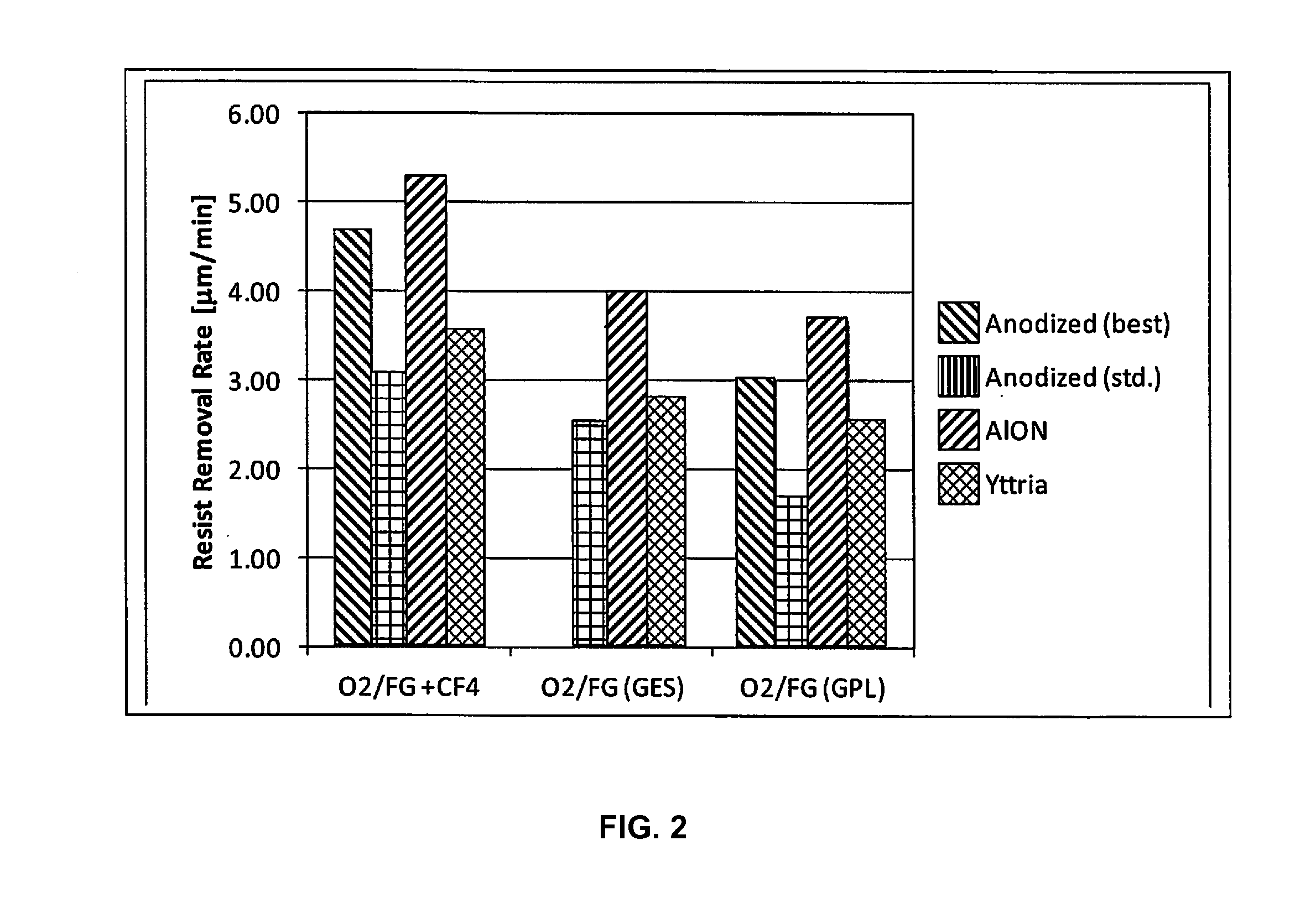Surface coating for chamber components used in plasma systems
a plasma system and surface coating technology, applied in vacuum evaporation coating, chemical vapor deposition coating, coatings, etc., can solve the problems of removing a substantial portion, substantially increasing plasma surface recombination rate, and no longer acceptable materials, so as to increase the efficiency of the system, increase the flow of excited plasma species, and reduce the effect of material recombination ra
- Summary
- Abstract
- Description
- Claims
- Application Information
AI Technical Summary
Benefits of technology
Problems solved by technology
Method used
Image
Examples
example 1
[0061]In this example, photoresist coated onto a 200 mm silicon substrate was exposed to plasma formed from oxygen and forming gas (3% hydrogen in nitrogen), using a Radiant Strip 220ES-IP plasma ashing tool, commercially available from Axcelis Technologies, Inc. A commercially available i-line photoresist was deposited onto the silicon substrate at a thickness of about 1.8 microns. The O2 / FG plasma chemistry was formed by flowing 90% of oxygen and 10% of forming gas at about 3.5 standard liters per minute (slm) into the plasma ashing tool at a pressure of about 1 Torr, a temperature of about 270° C., and a power setting of 2000 Watts.
[0062]Photoresist removal rate (also referred to as Ashing rate) and cross wafer uniformity of the O2 / FG plasma stripping process was determined after exposure of the photoresist to the respective plasma for 15 seconds. The Ashing rate was compared for two chamber baffle plate configurations:[0063](i) an anodized aluminum baffle plate with an optimized...
example 2
[0068]In this example, photoresist coated onto a 200 mm silicon substrate was exposed to various plasmas[0069](i) an O2 / FG plasma formed by flowing 90% of oxygen and 10% of forming gas into the plasma ashing tool at a pressure of about 1 Torr, a temperature of about 270° C., and a power setting of 2000 Watts;[0070](ii) an O2 / FG+CF4 plasma formed by flowing 90% of oxygen and 10% of forming gas, plus ˜0.15% CF4 into the plasma ashing tool at a pressure of about 1 Torr, a temperature of about 270° C., and a power setting of 2000 Watts.
and in two different plasma cleaning systems:[0071](i) a Radiant Strip 220ES-IP plasma ashing tool, commercially available from Axcelis Technologies, Inc.;[0072](ii) a Radiant Strip 220 plasma ashing tool, commercially available from Axcelis Technologies, Inc.
[0073]and for 4 different plasma tool baffle configurations:[0074](i) an optimized anodized aluminum baffle;[0075](ii) a standard anodized aluminum baffle;[0076](iii) an aluminum oxynitride coated al...
PUM
| Property | Measurement | Unit |
|---|---|---|
| temperatures | aaaaa | aaaaa |
| temperatures | aaaaa | aaaaa |
| thick | aaaaa | aaaaa |
Abstract
Description
Claims
Application Information
 Login to View More
Login to View More - R&D
- Intellectual Property
- Life Sciences
- Materials
- Tech Scout
- Unparalleled Data Quality
- Higher Quality Content
- 60% Fewer Hallucinations
Browse by: Latest US Patents, China's latest patents, Technical Efficacy Thesaurus, Application Domain, Technology Topic, Popular Technical Reports.
© 2025 PatSnap. All rights reserved.Legal|Privacy policy|Modern Slavery Act Transparency Statement|Sitemap|About US| Contact US: help@patsnap.com


